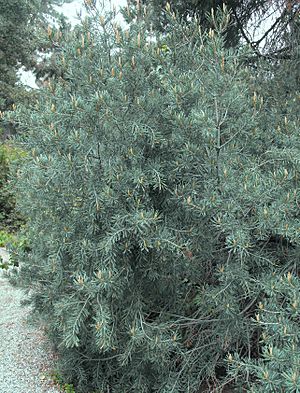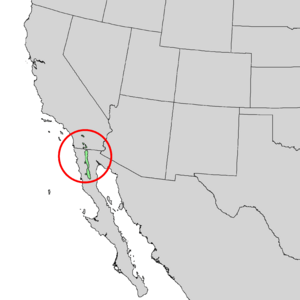Parry pinyon facts for kids
Quick facts for kids Parry pinyon |
|
|---|---|
 |
|
| Conservation status | |
| Scientific classification | |
 |
|
| Natural range of Pinus quadrifolia | |
| Synonyms | |
|
Pinus parryana |
The Parry pinyon (scientific name: Pinus quadrifolia) is a special type of pine tree. It's part of the pinyon pine family. You can find this tree growing in the very southern parts of California in the United States and in northern Baja California in Mexico.
This tree usually grows in mountains at medium heights, from about 4,300 feet (1,300 meters) to 5,900 feet (1,800 meters) above sea level. Sometimes, it can be found a bit lower or higher. The Parry pinyon is not super common and often grows scattered, forming open forests, usually mixed with juniper trees. People also call it the nut pine or fourleaf pinyon pine.
Contents
Meet the Parry Pinyon Tree
The Parry pinyon is a small to medium-sized tree. It can grow to be about 26 to 49 feet (8 to 15 meters) tall. Its trunk can be up to 16 inches (40 centimeters) wide. The bark on the tree is thick, rough, and scaly.
Parry Pinyon Needles and Cones
The leaves of the Parry pinyon are called needles. They usually grow in small bundles of 4 or 5 needles. These needles are about 1 to 2 inches (2.5 to 5.5 centimeters) long. They are shiny and dark green. The outer side of the needle is smooth, but the inner sides have bright white lines. These lines are where the tree "breathes" through tiny openings called stomata.
The cones are round and about 1.5 to 2 inches (4 to 5.5 centimeters) long when they are closed. They start out green. After about 18 to 20 months, they turn yellow or orange-brown when they are ready. These cones have only a few thick scales, usually 5 to 10 scales that hold seeds.
Seeds and How They Spread
When the cones are ready, they open up to about 2 to 2.75 inches (5 to 7 centimeters) wide. They hold their seeds on the scales even after opening. The seeds are about 0.4 to 0.5 inches (10 to 14 millimeters) long. They have a thin shell and a white inside part called an endosperm.
These seeds have a tiny wing, only about 0.04 to 0.08 inches (1 to 2 millimeters) long. They are mostly spread by a bird called the pinyon jay. This bird picks the seeds out of the open cones. The pinyon jay uses the seeds for food. It stores many of them for later. Some of these stored seeds are never eaten and can grow into new trees. This helps the Parry pinyon spread!
Parry Pinyon Hybrids
The Parry pinyon often mixes with another type of pine called the single-leaf pinyon (P. monophylla). This happens where their natural areas meet in southern California and northern Baja California. When they mix, they create what are called hybrids.
You can tell a hybrid because its needles are usually in bundles of 2 or 3. They also have some of those breathing lines (stomata) on their outer surface. Even though it mixes easily with the single-leaf pinyon, the Parry pinyon is actually more closely related to other pines. These include the Johann's pinyon and the Potosí pinyon. These relatives live over 600 miles (1000 kilometers) away!
How People Use Parry Pinyon
The seeds of the Parry pinyon are pine nuts, and they are edible! People collect them where the tree grows. However, they are not as widely collected as the seeds from the Colorado pinyon. Sometimes, the Parry pinyon is planted as a decorative tree. It is also sometimes used as a Christmas tree.
Since this tree doesn't grow in many places, its seeds are not collected for sale in stores. Birds, like the pinyon jay, and small animals, especially woodrats, eat most of the seeds.
Traditional Uses by Native Americans
The Cahuilla tribe, who live in southern California, used the Parry pinyon in many ways.
- They used the tree's sticky resin to make a face cream. Girls often used this cream to protect their skin from sunburn.
- The nuts were very important. They were given to babies as a food source. They were also ground up and mixed with water to make a drink.
- The nuts were roasted and eaten whole, or made into a soft food called mush.
- The Cahuilla also traded these nuts with other tribes.
- The pine needles and roots were used to make baskets.
- The bark was a good material for making roofs for houses.
- The resin also worked as a glue. It was used to fix broken pottery and to reattach arrowheads to arrow shafts.
- The wood was burned for firewood and as incense. It burned well and smelled nice.
The Diegueno tribe also ate the nuts and seeds from the Parry pinyon.


